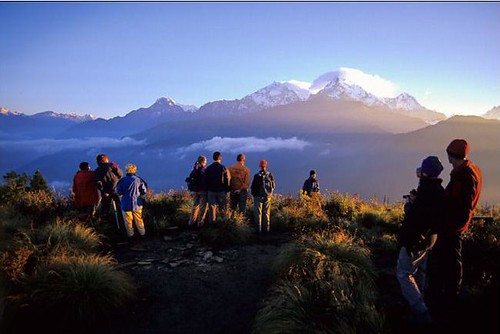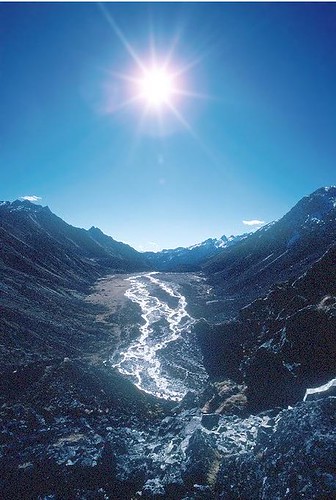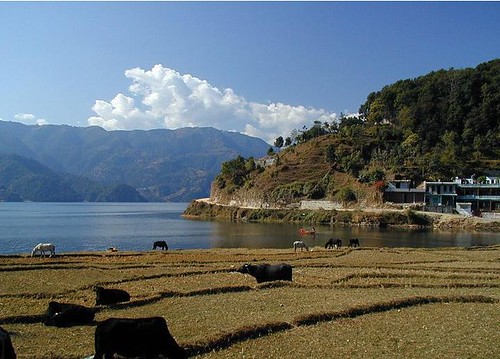
Nepal Nepal's snow-capped mountains Scenery -beautiful Nepal of Asia Natural Scenery
Nepal Scenery foto-Nepal's snow-capped mountains and lake scenery

Nepal of Asia Scenery -beautiful Nepal mountains
About Nepal:
Nepal's Nature: Nepal covers a span of 147,181 sq. kilometers ranging from altitude of 70 meters to 8,848 meters. Mountains, mid hills, valleys and plains dominate the geography of landlocked Nepal that extends from the Himalayan range in the north to the Indo-Gangetic lowlands in south. Mt. Everest, the highest point of the Himalayas is in Nepal.
Physical features also include green paddy terraces, wind-swept deserts, dense forests and marshy grasslands. The country is well endowed with perennial rivers, lakes and glacial lakes that originate in the Himalayas. Twenty percent of the land in the country is used for agriculture, where 0.49 percent is used for permanent crops, mainly rice.
Climatic conditions of Nepal vary from one place to another in accordance with the geographical features. In the north summers are cool and winters severe, while in south summers are sub tropical and winters mild.
The variety in Nepal's topography provides home to wildlife like tigers, rhinos, monkeys, bears, yaks, leopards and different species of insects and birds. Nepal is a home to almost 10 percent of the world's bird species among which 500 species are found in the Kathmandu Valley.
The country has managed to preserve some endangered species of Asia in its extensive parks and protected natural habitats. The most abundant natural resource in Nepal is water. Other resources found here are quartz, timber, lignite, copper, cobalt, iron ore and scenic beauty.
Physical features also include green paddy terraces, wind-swept deserts, dense forests and marshy grasslands. The country is well endowed with perennial rivers, lakes and glacial lakes that originate in the Himalayas. Twenty percent of the land in the country is used for agriculture, where 0.49 percent is used for permanent crops, mainly rice.
Climatic conditions of Nepal vary from one place to another in accordance with the geographical features. In the north summers are cool and winters severe, while in south summers are sub tropical and winters mild.
The variety in Nepal's topography provides home to wildlife like tigers, rhinos, monkeys, bears, yaks, leopards and different species of insects and birds. Nepal is a home to almost 10 percent of the world's bird species among which 500 species are found in the Kathmandu Valley.
The country has managed to preserve some endangered species of Asia in its extensive parks and protected natural habitats. The most abundant natural resource in Nepal is water. Other resources found here are quartz, timber, lignite, copper, cobalt, iron ore and scenic beauty.
Nepal' s people&customs: The population of Nepal was recorded to be about 25 million as of July 2002. Eighty-six percent of Nepalis follow Hinduism, while eight percent follow Buddhism and three percent follow Islam. The population comprises various groups of different races which are further divided into different castes. The distinction in caste and ethnicity is understood more easily with a view of customary layout of the population.
Some of the main groups are such: Gurungs and Magars who live mainly in the western region; Rais, Limbus and Sunwars who live in the eastern mid hills; Sherpas, Manangpas and Lopas who live near the mountains of Everest, Annapurna and Mustang respectively; Newars who live in and around the capital valley of Kathmandu; Tharus, Yadavas, Satar, Rajvanshis and Dhimals who live in the Terai region; and Brahmins, Chhetris and Thakuris generally spread over all parts of the country.
Nepali is the official language of the state, spoken and understood by 100 percent of the population. Multiple ethnic groups speak more than a dozen other languages in about 93 different dialects. English is spoken by many in government and business offices. It is the mode of education in most private schools of Kathmandu and some other cities.
Some of the main groups are such: Gurungs and Magars who live mainly in the western region; Rais, Limbus and Sunwars who live in the eastern mid hills; Sherpas, Manangpas and Lopas who live near the mountains of Everest, Annapurna and Mustang respectively; Newars who live in and around the capital valley of Kathmandu; Tharus, Yadavas, Satar, Rajvanshis and Dhimals who live in the Terai region; and Brahmins, Chhetris and Thakuris generally spread over all parts of the country.
Nepali is the official language of the state, spoken and understood by 100 percent of the population. Multiple ethnic groups speak more than a dozen other languages in about 93 different dialects. English is spoken by many in government and business offices. It is the mode of education in most private schools of Kathmandu and some other cities.
View Laos
Scenery Photos at: http://lotpictures.blogspot.com/2012/01/laos-scenery-photos.html
View Thailand Scenery photos at: http://lotpictures.blogspot.com/2008/12/thailand.html
View Vietnam Scenery Photos at: http://lotpictures.blogspot.com/2008/12/vit.html
View Thailand Scenery photos at: http://lotpictures.blogspot.com/2008/12/thailand.html
View Vietnam Scenery Photos at: http://lotpictures.blogspot.com/2008/12/vit.html
View Philippine
Scenery photos at: http://lotpictures.blogspot.com/2008/12/pli.html






No comments:
Post a Comment